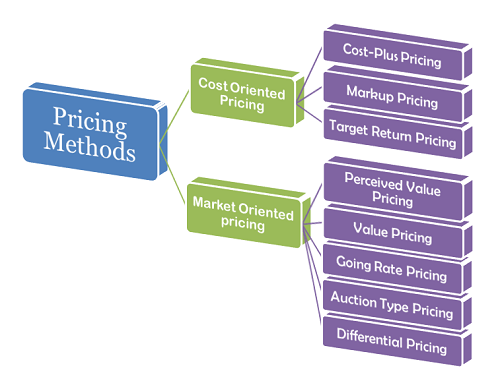Register now or log in to join your professional community.
What are the Pricing Methods? definition and meaning ?

Pricing methods are the methods that firms use to calculate the price of their products. Pricing is one of the toughest challenges encountered by the firms as the prices should not only be relevant as per the current market scenario, but should also meet the expenses of the firm and help it gain profit. It must also take into account competitor’s pricing. Hence, it is important to choose the right pricing method. The various pricing methods are as follows :

Definition: The Pricing Methods are the ways in which the price of goods and services can be calculated by considering all the factors such as the product/service, competition, target audience, product’s life cycle, firm’s vision of expansion, etc. influencing the pricing strategy as a whole.
The pricing methods can be broadly classified into two parts:
 Cost-Oriented Pricing Method: Many firms consider the Cost of Production as a base for calculating the price of the finished goods. Cost-oriented pricing method covers the following ways of pricing:
Cost-Oriented Pricing Method: Many firms consider the Cost of Production as a base for calculating the price of the finished goods. Cost-oriented pricing method covers the following ways of pricing:
E.g. If the Cost of Production of product-A is Rs 500 with a markup of 25% on total cost, the selling price will be calculated asSelling Price= cost of production + Cost of Production x Markup Percentage/100Selling Price=500+500 x 0.25= 625Thus, a firm earns a profit of Rs 125 (Profit=Selling price- Cost price)
Markup Price= Unit Cost/ 1-desired return on salesMarkup Price= 16/1-0.20 = 20Thus, the producer will charge Rs 20 for one chocolate and will earn a profit of Rs 4 per unit.
Target return price= Unit Cost + (Desired Return x capital invested)/ unit salesTarget Return Price=16 + (0.20 x 100000)/5000Target Return Price= Rs 20
Thus, Manufacturer will earn 20% ROI provided that unit cost and sale unit is accurate. In case the sales do not reach 50,000 units then the manufacturer should prepare the break-even chart wherein different ROI’s can be calculated at different sales unit.
Market-Oriented Pricing Method: Under this method price is calculated on the basis of market conditions. Following are the methods under this group:
E.g. Customer buy Sony products despite less price products available in the market, this is because Sony company follows the perceived pricing policy wherein the customer is willing to pay extra for better quality and durability of the product.
E.g. Tata Nano is the best example of value pricing, despite several Tata cars, the company designed a car with necessary features at a low price and lived up to its quality.
E.g. In Oligopolistic Industry such as steel, paper, fertilizer, etc. the price charged is same.
2. Dutch Auctions– There may be one seller and many buyers or one buyer and many sellers. In the first case, the top best price is announced and then slowly it comes down that suit the bidder whereas in the second kind buyer announces the product he wants to buy then potential sellers competes by offering the lowest price.
3. Sealed-Bid Auctions: This kind of method is very common in the case of Government or industrial purchases, wherein tenders are floated in the market, and potential suppliers submit their bids in a closed envelope, not disclosing the bid to anyone.
E.g. The best example of differential pricing is Mineral Water.The price of Mineral Water varies in hotels, railway stations, retail stores.
Thus, the companies can adopt either of these pricing methods depending on the type of a product it is offering and the ultimate objective for which the pricing is being done.



